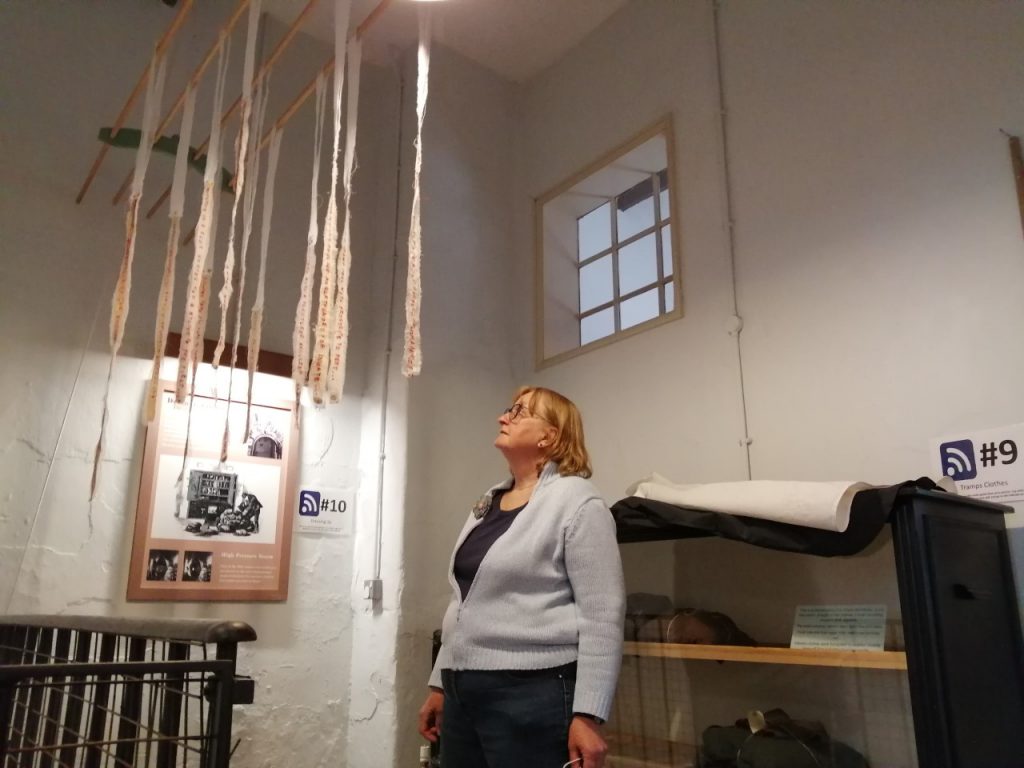From 17 May to 5 September 2021, the Workhouse Museum is home to an exhibition created by Yorkshire-based textiles group 6-Ply, featuring five textile installations.
Inspired by historical research into the theme of workhouse women, the artists used a variety of materials and techniques to convey the real experiences and imagined emotions of life as a woman in Ripon Workhouse.
Room for Mother & Infant, by Hazel Waite
The artist has a personal connection to Ripon Workhouse: her father-in-law was born there.
Interested in the theme of birth and motherhood, she studied workhouse literature, records and displays, considering the attitude people had towards the women – mostly single – who gave birth in the workhouse and what life was like for them.
This installation takes the form of a hanging made to the approved size of a mother and infant bed, to emphasise their tiny size. A life-sized mother and baby image is surrounded by the names of the women and children associated with the 73 births in Ripon Workhouse between 1901 and 1920.
Jane Button’s “Fancy Apron”, by Sarah Lowe
In 1896, a female Guardian at Ripon Workhouse made an unsuccessful attempt to persuade others that the nurse, Jane Button, should wear an apron, cap and cuffs so she could be recognised easily. The nurse had been wearing a “fancy apron” but was determined that she would not wear a nurse’s apron.
Reducing the spread of disease by wearing protective clothing is an important part of current medical care, in sharp contrast with this account. Contemporary reports of medical care in provincial workhouses show that the conditions were often poor.
Ripon Workhouse records show that the patients being cared for had a wide range of conditions, which meant the apron would have come into contact with everyday grime and bodily fluids on the ward. While it might look “fancy” from a distance, it would have been a health risk.
Veg, Glorious Veg, by Mary Exelby
In the workhouse, inmates received a set amount of food each day. They had the right to question what they were given and have it weighed in front of them.
In Ripon, most food was bought in from local suppliers. But the inmates were able to work in the kitchen garden, where they grew vegetables, which would supplement their plain, simple meals. Potatoes, carrots, cabbage and onions are mentioned in the 1886 Garden Account Book.
Contemporary guidance shows that potatoes were cooked with the skins on and vegetables were cooked with salt to kill insects.
Apron of Feelings, by Jenny Bradbury
This installation represents an item of clothing that would have been part of the everyday uniform of a workhouse inmate. The design reflects the practicalities of workhouse life, as well as the often fragile and vulnerable state of workhouse inmates.
The words displayed reveal some of the experiences and emotions the inmates encountered. The labels also aim to highlight impressions and judgements that some outside communities held of the inmates and the stigma this carried.
Fragments, by Eileen Sweeney
Harriet Rodwell died of suicide barely three months after entering Ripon Workhouse. As a resident, not a vagrant, she must have had local connections – indeed the Parish of Sawley contributed to her funeral.
At her inquest, recorded in the York Herald on 8 December 1855, it was noted that on a previous occasion she had been confined in a lunatic asylum, though no signs of insanity were observed at Ripon. She “usually appeared dejected” but spoke “in a rational manner”. It was reported that she was always craving tobacco.
Harriet has left but the barest traces, remembered only for the manner of her dying. The final installation in this exhibition is likewise ephemeral and lightly defined, with mere fragments of a life and a sad shadow of a woman.
To read more about the lives of some of the women who passed through Ripon Workhouse, explore the More Than Oliver Twist project.
